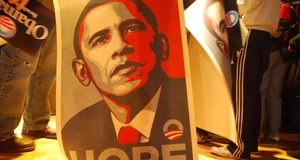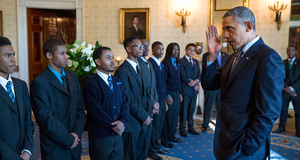Exit Surveys
Three exit surveys were held to ask questions on their demographics and their perception of can-didates, along with one open-ended question. (See Table 1 for full survey results from this section of analy-sis.). In a survey after Debate 1, there were 20 Democrats, 1 Republican and 12 in the Independents/Other category. In the second survey, there were 6 Democrats and 4 in the Independents/Other category. In the third survey, there were 20 Democrats, 2 Republicans, 6 in the Independents/Other category, and 1 with no answer. The participants were composed of 38 females and 28 males in thee surveys combined. One did not indicate his or her gender.
Obama was their chosen candidate for 23, 8 and 23 participants in each of three surveys respectively.
Romney was chosen as their favored candidate by 3, 0, and 2 participants in each of three surveys. There were three participants who favored the other candidate.
Including responses from all three debates, 77 percent of respondents said the debate did not influ-ence for whom they intended to vote. This supports Sides’ theory that presidential debates don’t actually matter in determining the outcome of an election. Just four respondents across all three said the debate performance changed their mind about their candidate selection. Across all debates, the respondents, who said they were moderately to extremely politically aware, also ranked the performances of both candidates in terms of truth with little variation. They gave Obama a “truthfulness ranking” of 3.8 out of 5, while giving Rom-ney just 2.6 out of 5. More respondents also said Obama was either “straightforward” or “somewhat straight-forward” far more often than they did Romney, who was more often ranked “somewhat straightforward” or “not straightforward.”
The opinions and preferences of the survey-takers were very skewed towards the Democratic Party and President Obama (65 percent identified as Democrat and 76 percent said they were going to vote for Obama). At all three events combined, just three people identified as Republican. Within the surveys, there were also several contradictory answers (respondents who identified as voting for a specific candidate also said the debate had left them still undecided). Several respondents also left questions unanswered.

The second half of the exit survey included qualitative answers about the candidates’ debate perfor-mances. Respondents were asked to identify the topics about which the candidates had been truthful or un-truthful. In the three debates, the greatest percentage of respondents ranked Obama “truthful” about “health care” for Debate 1 and “foreign policy” for Debates 2 and 3, as shown in Table 2. When another question was asked, on which topic was the candidate not truthful, most people chose “Don’t know,” followed by “economy.”
Obama’s opponent, Romney, had the greatest percentage of respondents say he was “truthful” about the “economy” for Debates 1 and 2. For Debate 3, the largest number of respondents said “don’t know.” When they were asked on which topic was the candidate not truthful, the greatest percentage of respondents said he was “not truthful” about the “economy” for Debate 1 (curiously the same topic about which he was also “truthful”). For Debate 2, there was not a dominant category. For Debate 3, it was “don’t know,” followed by “foreign policy.”
It is worth noting that the “economy” is highly ranked as a “truthful” and a “not truthful” topic for both Obama and Romney in debates, perhaps indicating that the respondents are unable to identify when a candi - date is telling a truth or lying about the economy, despite the fact that they consider themselves to possess a moderate to high level of political awareness. The alternative interpretation is that both Romney and Obama told truths and lies about the economy and that the respondents just focused on those that fit the framework they had already established about a particular candidate.

The Debates’ Impact on the Election
By examining polling numbers from before and after each debate, it can be seen that none caused a dramatic shift in numbers for either Obama or Romney (see Table 3).

It can be seen that Romney increased (marginally) in popularity among all voters polled as Election Day approached, while Obama decreased (by a single point), again, not dramatically. At no point during debate season did Romney surpass Obama in polling numbers, and was unable to unseat the incumbent president on November 6, 2012. No media outlet of significance said any debate was a “game changer” or likely to affect the election.
In fact, with the incumbent winning the presidency, with the Republican Party retaining control of the House and the Democratic Party keeping their majority in the Senate, the 2012 election was a “status quo” one, meaning nothing changed. Arguably, all three debates could have been skipped altogether without af - fecting the outcome whatsoever. This is, of course, disputable. Perhaps Romney might have experienced a late surge had he not had the debates to limit his growth. Or, maybe Obama would have won by a far wider margin if he hadn’t had the debates to tarnish his image at all. This is all speculation, of course.Continued on Next Page »
“2012 presidential debate: President Obama and Mitt Romney’s remarks in Denver on Oct. 3,” The Washing-ton Post, October 3, 2012, http://www.washingtonpost.com/ politics/decision2012/2012-presidential-debate-president-obama-and-mitt-romneys-remarks-in-denver-on-oct-3-running-transcript/2012/10/03
/24d6eb6e-0d91-11e2-bd1a-b868e65d57eb_story.html (Retrieved on November 15, 2012).
Beoit, William, Glenn Hansen, and Rebecca Verser. “A meta-analysis of the effects of view-ing U.S. presidential debates.” Communications Monographs 70, no. 4, http://dx.doi. org/10.1080/0363775032000179133 (December 2003).
Birdsell, David S., and Kathleen Hall Jamieson. Presidential Debates: The Challenge of Creating an Informed Electorate. New York: Oxford University Press, 1988.
“CBS News Instant Poll: Romney wins first presidential debate,” CBS News, October 3, 2012, http://www. cbsnews.com/video/watch/?id=7424218n (November 15, 2012).
“CNN Poll: Most watchers say Romney debate winner,” CNN, October 3, 2012, http://politicalticker.blogs.cnn. com/2012/10/03/cnn-poll-romney-wins-debate-by-big-margin/ (November 15, 2012).
“CNN Poll: Nearly half of debate watchers say Obama won showdown,” CNN, October 22, 2012, http://politi-calticker.blogs.cnn.com/2012/10/22/cnn-poll-who-won-the-debate/ (November 15, 2012).
Davidson, Paul, Susan Davis, Gregory Korte, Aamer Madhani, and Tim Mullaney. Debate fact check: Revisit-ing claims on jobs, education,” USA TODAY, October 17, 2012, http://www.usatoday.com/story/news/ politics/2012/10/16/the-fact-check-a-second-look-at-claims-on-jobs-education/1637861/ (November 15, 2012).
Davidson, Paul, Susan Davis, Gregory Korte, and Tim Mullaney, “Debate fact check: 2nd look at taxes, job gains,” USA TODAY, October 4, 2012, http://www.usatoday.com/story /news/politics/2012/10/03/fact-checking-the-debate/1612241/ (November 15, 2012).
Davidson, Paul, Alan Gomez, Gregory Korte, Tim Mullaney and Tom Vanden Brook, “Fact check: Claims about Syria, Libya, Iraq scrutinized,” USA TODAY, October 23, 2012, http://www.usatoday.com/story/ news/politics/2012/10/22/fact-check-third-presidential-debate/1650865/, (November 15, 2012).
Dawes, Robyn M., Insights in Decision Making. Chicago: University of Chicago Press, 1990.
“Dubious Denver Debate Declarations,” FactCheck.Org, October 4, 2012, http://factcheck.org/2012/10/dubi-ous-denver-debate-declarations/ (November 15, 2012).
“FactChecking the Hofstra Debate,” FactCheck.Org, October 17, 2012, http://factcheck.org /2012/10/fact-checking-the-hofstra-debate/, (November 15, 2012).
“False Claims in Final Debate,” FactCheck.Org, October 23, 2012, http://factcheck.org/ 2012/10/false-claims-in-final-debate/ (November 15, 2012).
Kraus, Sidney. “Winners of the First 1960 Televised Presidential Debate Between Kennedy and Nix-on.” Journal of Communications 46, no. 4 (December 1996), http://online library.wiley.com/ doi/10.1111/j.1460-2466.1996.tb01507.x/abstract.
Truth and Context in the 2012 Presidential Debates by Rachel Southmayd — 25
Noonan, Peggy. “2012 Debates: This is it, Mitt.” The Wall Street Journal, September 28, 2012, http://online. wsj.com/article/SB10000872396390443916104578022811 751382342.html (November 15, 2012).
“Poll: CNN Poll: Who won the second presidential debate?” CNN, October 16, 2012, http:// www.cnn.com/ POLITICS/pollingcenter/polls/3274 (November 15, 2012).
“Poll: Decisive win for Obama in final debate,” CBS News, October 22, 2012, http://www. cbsnews.com/8301-250_162-57537795/poll-decisive-win-for-obama-in-final-debate/ (November 15, 2012).
“Poll: Obama edges Romney in second presidential debate,” CBS News, October 16, 2012, http://www.cb-snews.com/video/watch/?id=50133279n (November 15, 2012).
Romney, Mitt, “Let Detroit Go Bankrupt,” New York Times, November 18, 2008, http:// www.nytimes. com/2008/11/19/opinion/19romney.html?_r=1& (November 15, 2012).
Sherrod, Drury. “Selective Perception of Political Candidates.” The Public Opinion Quarterly 35, no. 4 (1971), http://www.jstor.org/stable/2747672
Sides, John. “Do Presidential Debates Really Matter?” Washington Monthly, September/October 2012, http:// www.washingtonmonthly.com/magazine/Septem beroctober_2012/ten_miles_square/do_presiden-tial_debates_really039413.php
Stephy, M.J. “Top 10 Debate Flubs: Gerald Ford, 1976.” Time, June 13, 20122, http://www. time.com/time/ specials/packages/article/0,28804,2077515_2077516_2077513,00.html (October 21, 2012).
Stratford, Michael, “In Debate, Romney Voices Support for Expanding Pell Grant,” Chronicle of Higher Educa-tion, October 17, 2012, http://chronicle.com/blogs/decision2012 /2012/10/17/in-debate-romney-voic-es-support-for-expanding-pell-grant-program/ (November 15, 2012).
“Transcript and Audio: Second Presidential Debate,” NPR, October 16, 2012. http://www. npr. org/2012/10/16/163050988/transcript-obama-romney-2nd-presidential-debate (November 15, 2012).
“Transcript: Presidential debate, Oct. 22, 2012 (text, video),” Politico, October 22, 2012, http://www.politico. com/news/stories/1012/82712.html (November 15, 2012).
“U.S. Navy Active Ship Force Levels, 1886-present,” Naval History and Heritage Command,” June 10, 2011, http://www.history.navy.mil/branches/org9-4.htm#2000 (November 15, 2012).
“U.S. Presidential Election Center,” Gallup, November 8, 2012, http://www.gallup.com/ poll/154559/US-Presi-dential-Election-Center.aspx (November 15, 2012).
Endnotes
1.) David S. Birdsell and Kathleen Hall Jamieson. Presidential Debates: The Challenge of Creating an Informed Electorate (New York: Oxford University Press, 1988), 5.
2.) Sidney Kraus, “Winners of the First 1960 Televised Presidential Debate Between Kennedy and Nixon,” Jour-nal of Communication 46, no. 4 (1996, http://onlinelibrary.wiley.com/doi/ 10.1111/j.1460-2466.1996.tb01507.x/ abstract).
3.) William Benoit, et al., “A meta-analysis of the effects of viewing U.S. presidential debates,” Communication Monographs 70, no. 4 (2003), http://dx.doi.org/10.1080/0363775032000 179133.
4.) Presidential Debates, 10.
5.) “A meta-analysis,” 336.
6.) Ibid.
7.) John Sides, “Do Presidential Debates Really Matter?” Washington Monthly, September/October 2012, http://www.washingtonmonthly.com/magazine/septemberoctober_2012/ten_miles_square/do_presidential_de-bates_really039413.php (October 21, 2012).
8.) Ibid.
9.) M.J. Stephy, “Top 10 Debate Flubs: Gerald Ford, 1976,” Time, June 13, 2011, http://www.time.com/time/ specials/packages/article/0,28804,2077515_2077516_2077513,00.html (October 21, 2012).
10.) “Do Presidential Debates Really Matter?”
11.) Peggy Noonan, “2012 Debates: This is it, Mitt,” The Wall Street Journal, September 28, 2012, http://online. wsj.com/article/SB1000087239639044391610457802281175138 2342.html (November 15, 2012).
12.) “A meta-analysis,” 336.
13.) “Do Presidential Debates Really Matter?”
14.) “Dubious Denver Debate Declarations,” FactCheck.Org, October 4, 2012, http://factcheck.org/2012/10/ dubious-denver-debate-declarations/ (November 15, 2012).
15.) “2012 presidential debate: President Obama and Mitt Romney’s remarks in Denver on Oct. 3,” The Wash-ington Post, October 3, 2012, http://www.washingtonpost.com/politics/ decision2012/2012-presidential-de-bate-president-obama-and-mitt-romneys-remarks-in-denver-on-oct-3-running-transcript/2012/10/03/24d6eb6e -0d91-11e2-bd1a-b868e65d57eb_story.html, (November 15, 2012).
16.) Paul Davidson, et al., “Debate fact check: 2nd look at taxes, job gains,” USA TODAY, October 4, 2012, http://www.usatoday.com/story/news/politics/2012/10/03/fact-checking-the-debate/1612241/, (November 15, 2012).
17.) “2012 presidential debate.”
18.) “Dubious Denver Debate Declarations.”
19.) Ibid.
20.) Davidson, et al.
21.) “CNN Poll: Most watchers say Romney debate winner,” CNN, October 3, 2012, http://politicalticker.blogs. cnn.com/2012/10/03/cnn-poll-romney-wins-debate-by-big-margin/, November 15, 2012.
22.) “CBS News Instant Poll: Romney wins first presidential debate,” CBS News, October 3. 2012, http://www. cbsnews.com/video/watch/?id=7424218n, November 15, 2012.
23.) “Transcript and Audio: Second Presidential Debate,” NPR, October 16, 2012, http://www.npr. org/2012/10/16/163050988/transcript-obama-romney-2nd-presidential-debate, November 15, 2012.
24.) Michael Stratford, “In Debate, Romney Voices Support for Expanding Pell Grant,” Chronicle of Higher Education, October 17, 2012, http://chronicle.com/blogs/decision 2012/2012/10/17/in-debate-romney-voices-support-for-expanding-pell-grant-program/
25.) “FactChecking the Hofstra Debate,” FactCheck.Org, October 17, 2012, http://factcheck. org/2012/10/fact-checking-the-hofstra-debate/, November 15, 2012.
26.) Ibid.
27.) Paul Davidson, et al, “Debate fact check: 2nd look at taxes, job gains,” USA TODAY, October 4, 2012, http://www.usatoday.com/story /news/politics/2012/10/03/fact-checking-the-debate/1612241/, (November 15, 2012).
28.) “FactChecking the Hofstra Debate.”
29.) “Transcript and Audio: Second Presidential Debate.”
30.) “Poll: CNN Poll: Who won the second presidential debate?” CNN, October 16, 2012, http:// www.cnn.com/ POLITICS/pollingcenter/polls/3274, (November 15, 2012).
31.) “Poll: Obama edges Romney in second presidential debate,” CBS News, October 16, 2012, http://www. cbsnews.com/video/watch/?id=50133279n, (November 15, 2012).
32.) “U.S. Navy Active Ship Force Levels, 1886-present,” Naval History and Heritage Command,” June 10, 2011, http://www.history.navy.mil/branches/org9-4.htm#2000, (November 15, 2012).
33.) “Transcript: Presidential debate, Oct. 22, 2012 (text, video),” Politico, October 22, 2012, http://www.politico. com/news/stories/1012/82712.html, (November 15, 2012).
34.) “Transcript: Presidential debate.”
35.) Mitt Romney, “Let Detroit Go Bankrupt,” New York Times, November 18, 2008, http:// www.nytimes. com/2008/11/19/opinion/19romney.html?_r=1&, (November 15, 2012).
36.) “False Claims in Final Debate,” FactCheck.Org, October 23, 2012, http://factcheck.org/ 2012/10/false-claims-in-final-debate/, (November 15, 2012).
37.) Ibid.
38.) Ibid.
39.) “Poll: Decisive win for Obama in final debate,” CBS News, October 22, 2012, http://www. cbsnews. com/8301-250_162-57537795/poll-decisive-win-for-obama-in-final-debate/ (November 15, 2012).
40.) “CNN Poll: Nearly half of debate watchers say Obama won showdown,” CNN, October 22, 2012, http://po-liticalticker.blogs.cnn.com/2012/10/22/cnn-poll-who-won-the-debate/, (November 15, 2012).
41.) “U.S. Presidential Election Center,” Gallup, November 8, 2012, http://www.gallup.com/ poll/154559/US-Presidential-Election-Center.aspx, (November 15, 2012).
42.) Robyn M. Dawes, Insights in Decision Making (Chicago: University of Chicago Press, 1990), 179. 43 Drury Sherrod, “Selective Perception of Political Candidates,” The Public Opinion Quarterly 35, no. 4 (1971), http://www.jstor.org/stable/2747672.






















